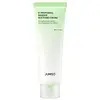What's inside
What's inside
 Key Ingredients
Key Ingredients

 Benefits
Benefits

 Concerns
Concerns

No concerns
 Ingredients Side-by-side
Ingredients Side-by-side

Water
Skin ConditioningSqualane
EmollientPanthenol
Skin ConditioningPropanediol
SolventEctoin
Skin ConditioningGlyceryl Glucoside
HumectantBetaine
HumectantAmmonium Polyacryloyldimethyl Taurate
Emulsion StabilisingCyclopentasiloxane
EmollientXylitylglucoside
HumectantAnhydroxylitol
HumectantXylitol
HumectantInulin
Skin ConditioningAlpha-Glucan Oligosaccharide
CleansingAcetyl Heptapeptide-4
HumectantBenzylsulfonyl D-Seryl Homophenylalanine Amidinobenzamide Acetate
Skin ConditioningPolyglutamic Acid
Skin ConditioningSodium Dna
Skin ConditioningTrehalose
Humectant1,2-Hexanediol
Skin ConditioningCaprylhydroxamic Acid
Tremella Fuciformis Sporocarp Extract
AntioxidantCaprylyl Glycol
EmollientTocopheryl Acetate
AntioxidantWater, Squalane, Panthenol, Propanediol, Ectoin, Glyceryl Glucoside, Betaine, Ammonium Polyacryloyldimethyl Taurate, Cyclopentasiloxane, Xylitylglucoside, Anhydroxylitol, Xylitol, Inulin, Alpha-Glucan Oligosaccharide, Acetyl Heptapeptide-4, Benzylsulfonyl D-Seryl Homophenylalanine Amidinobenzamide Acetate, Polyglutamic Acid, Sodium Dna, Trehalose, 1,2-Hexanediol, Caprylhydroxamic Acid, Tremella Fuciformis Sporocarp Extract, Caprylyl Glycol, Tocopheryl Acetate
Water
Skin ConditioningPropanediol
SolventGlycerin
HumectantPanthenol
Skin ConditioningButylene Glycol
HumectantCaprylic/Capric Triglyceride
MaskingSqualane
Emollient1,2-Hexanediol
Skin ConditioningCarbomer
Emulsion StabilisingArginine
MaskingCetearyl Olivate
Ethylhexylglycerin
Skin ConditioningSorbitan Olivate
EmulsifyingCetearyl Alcohol
EmollientAllantoin
Skin ConditioningBetaine
HumectantCeramide NP
Skin ConditioningHydrogenated Lecithin
EmulsifyingDipropylene Glycol
HumectantGlyceryl Stearate
EmollientHydroxypropyl Bislauramide Mea
EmollientMadecassoside
AntioxidantAsiaticoside
AntioxidantMadecassic Acid
Skin ConditioningAsiatic Acid
Skin ConditioningTocopherol
AntioxidantCholesterol
EmollientCeramide Ns
Skin ConditioningCeramide AP
Skin ConditioningCeramide As
Skin ConditioningPhenylalanine
MaskingLeucine
Skin ConditioningMethionine
Skin ConditioningLysine
Skin ConditioningHistidine
HumectantIsoleucine
Skin ConditioningValine
MaskingThreonine
Tryptophan
MaskingCeramide EOP
Skin ConditioningWater, Propanediol, Glycerin, Panthenol, Butylene Glycol, Caprylic/Capric Triglyceride, Squalane, 1,2-Hexanediol, Carbomer, Arginine, Cetearyl Olivate, Ethylhexylglycerin, Sorbitan Olivate, Cetearyl Alcohol, Allantoin, Betaine, Ceramide NP, Hydrogenated Lecithin, Dipropylene Glycol, Glyceryl Stearate, Hydroxypropyl Bislauramide Mea, Madecassoside, Asiaticoside, Madecassic Acid, Asiatic Acid, Tocopherol, Cholesterol, Ceramide Ns, Ceramide AP, Ceramide As, Phenylalanine, Leucine, Methionine, Lysine, Histidine, Isoleucine, Valine, Threonine, Tryptophan, Ceramide EOP
 Reviews
Reviews

Ingredients Explained
These ingredients are found in both products.
Ingredients higher up in an ingredient list are typically present in a larger amount.
1,2-Hexanediol is a synthetic liquid and another multi-functional powerhouse.
It is a:
- Humectant, drawing moisture into the skin
- Emollient, helping to soften skin
- Solvent, dispersing and stabilizing formulas
- Preservative booster, enhancing the antimicrobial activity of other preservatives
Betaine is a common humectant (a substance that promotes retention of moisture). It's known to be gentle on the skin and can help balance hydration.
This ingredient is best for improving hydration and soothing irritated skin. Studies also show it helps even out skin tone.
Fun fact: Betaine is naturally created in the skin and body. The kind found within cosmetic products can be either plant-derived or synthetic.
Another name for betaine is trimethylglycine.
Learn more about BetainePanthenol is a common ingredient that helps hydrate and soothe the skin. It is found naturally in our skin and hair.
There are two forms of panthenol: D and L.
D-panthenol is also known as dexpanthenol. Most cosmetics use dexpanthenol or a mixture of D and L-panthenol.
Panthenol is famous due to its ability to go deeper into the skin's layers. Using this ingredient has numerous pros (and no cons):
Like hyaluronic acid, panthenol is a humectant. Humectants are able to bind and hold large amounts of water to keep skin hydrated.
This ingredient works well for wound healing. It works by increasing tissue in the wound and helps close open wounds.
Once oxidized, panthenol converts to pantothenic acid. Panthothenic acid is found in all living cells.
This ingredient is also referred to as pro-vitamin B5.
Learn more about PanthenolPropanediol is an all-star ingredient. It softens, hydrates, and smooths the skin.
It’s often used to:
Propanediol is not likely to cause sensitivity and considered safe to use. It is derived from corn or petroleum with a clear color and no scent.
Learn more about PropanediolSqualane is an emollient that helps the skin hold onto moisture. It's an oily liquid that occurs naturally in certain types of fish and plant oils.
Because squalane boosts hydration in the skin, it also comes with plenty of benefits: it is an antioxidant and can help fight free radicals and skin damage. Squalane is also found to have a detoxifying effect when applied.
Squalane comes from squalene, which occurs naturally within the sebum of our skin. It is one of the oils our skin produces to keep itself hydrated. Squalane is the hydrogenated version of squalene and has a longer shelf life.
Research shows that squalane is non-irritating (even at 100% concentration).
In general, it's a fantastic ingredient. It does a great job at hydrating the skin, and it's suitable for those with sensitive skin.
The source of squalane may impact malassezia / fungal acne. This is because olive oil derived squalane can contain impurities such as fatty acids and plant waxes. Sugarcane derived squalane is recommended for anyone with malassezia concerns.
Is squalane vegan?
This depends on the source. Squalane can be derived from both plants and animals. Most squalane used in skincare comes from plants.
Please note: the source of squalane is only known if disclosed by the brand. We recommend reaching out to the brand if you have any questions about their squalane.
Read more about squalene with an "e".
Is squalane an oil?
Squalane is often called an oil, but it’s technically not; it’s a hydrocarbon, meaning it’s only made of carbon and hydrogen, unlike true oils which are triglycerides made of fatty acids and glycerol.
The term “oil-free” isn’t regulated, so companies can define it however they want. Some exclude all oils, while others just avoid mineral oil or comedogenic oils.
While some people avoid oils thinking they cause breakouts, the right kind of oil (or oil-like ingredient like squalane) can actually help balance and hydrate your skin. It’s worth testing out simple oils or squalane to see what works best for your skin.
Learn more about SqualaneWater. It's the most common cosmetic ingredient of all. You'll usually see it at the top of ingredient lists, meaning that it makes up the largest part of the product.
So why is it so popular? Water most often acts as a solvent - this means that it helps dissolve other ingredients into the formulation.
You'll also recognize water as that liquid we all need to stay alive. If you see this, drink a glass of water. Stay hydrated!
Learn more about Water